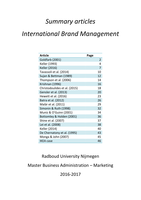Samenvatting
Summary articles International Brand Management
- Instelling
- Radboud Universiteit Nijmegen (RU)
Summary of all articles for the course International Brand Management in the master Marketing, Radboud University, . Includes the following articles: Goldfarb (2001), Keller (1993), Keller (2016), Tavassoli et al. (2014), Sujan & Bettman (1989), Thompson et al. (2006), Krishnan (1996) Christodoulid...
[Meer zien]




